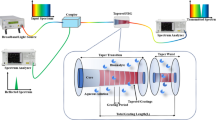Abstract
We report the application of the analytical and finite element methods to the analysis of the sensing performance for the Bragg fiber-based plasmonic sensors having four layers. The advantages of an optical fiber with four (SiO2, GaP, gold, and H2O) layers are a very large value of the amplitude sensitivity (3708.8 refractive index units (RIU)−1), large values of the loss (3091.0 dB/cm) and the power fraction P (0.36) at the loss matching point for the core mode in H2O, a small value of the full width at half maximum (19.4 nm), a smaller value (2.1 nm) of the difference Δλ between maximal amplitude sensitivity and resonant wavelengths, and a symmetric line shape of the wavelength-dependent loss but a small spectral sensitivity (3236 nmRIU−1). A modification in the geometry of the fiber produces a significant change in the sensitivity and in the propagation parameters of the device. Thus, the advantages of another optical fiber with four layers are a very large value of spectral sensitivity ( nmRIU−1), large values of the amplitude sensitivity (2084.4 RIU−1), and the loss (3214.5 dB/cm) and the power fraction P (0.35), but the difference Δλ is large (8.6 nm) and the line shape for the wavelength dependence of the imaginary part of the effective index is asymmetric.








Similar content being viewed by others
References
Skorobogatiy M (2009) Microstructured and photonic bandgap fibers for applications in the resonant bio-and chemical sensors. J Sens 524237:1–20. doi:10.1155/2009/524237
Gauvreau B, Hassani A, Fassi Fehri M, Kabashin A, Skorobogatiy M (2007) Photonic bandgap fiber-based surface plasmon resonance sensors. Opt Express 15(18):11413–11426. doi:10.1364/OE.15.011413
Popescu VA, Puscas NN, Perrone G (2015) Efficient light absorption in a new Bragg fiber-based plasmonic sensor. J Opt Soc Am B 32(3):473–478. doi:10.1364/JOSAB.32.000473
Dhara P, Fallauto C, Braglia A, Olivero M, Popescu VA, Puscas NN, Vallan A, Singh VK, Perrone G (2015) Optical fibers and sensors for medical diagnostics and treatment applications XV. In: Gannot I (ed) Proc. SPIE 9317: 1–9, San Francisco. doi:10.1117/12.2078157
Popescu VA and Puscas NN (2015) Propagation characteristic in a new photonic fiber based plasmonic sensor. Rom. Rep. Phys. 67(2): 500–507, http://www.rrp.infim.ro/2015_67_2/A20.pdf
Shuai B, Xia L, Zhang Y, Liu D (2012) A multi-core holey fiber based plasmonic sensor with large detection range and high linearity. Opt Express 20(6):5974–5986. doi:10.1364/OE.20.005974
Homola J (2008) Surface plasmon resonance sensors for detection of chemical and biochemical species. Chem Rev 108:462–493. doi:10.1021/cr068107d
Zhang Y, Xia L, Zhou C, Yu X, Liu H, Liu D, Zhang Y (2011) Microstructured fiber based plasmonic index sensor with optimized accuracy and calibration relation in large dynamic range. Opt Commun 284(18):4161–4166. doi:10.1016/j.optcom.2011.04.053
Sharma AK, Rajan R, Gupta BD (2007) Influence of dopants on the performance of a fiber optic surface plasmon resonance sensor. Opt Commun 274(2):320–326
Verma RK, Sharma AK, Gupta BD (2008) Surface plasmon resonance based tapered fiber optic sensor with different taper profiles. Opt Commun 281:1486–1491
Ghatak AK and Thyagarajan K (1999) Introduction to Fiber Optics, Cambridge University Press, New Delhi
Daimon M, Masumura A (2007) Measurement of the refractive index of distilled water from the neared-infrared region to the ultraviolet region. Appl Opt 46(18):3811–3820
Ordal MA, Long LL, Bell RJ, Bell SE, Bell RR, Alexander RW Jr, Ward CA (1983) Optical properties of the metals Al, Co, Cu, Au, Fe, Pb, Ni, Pd Pt Ag, Ti, and W in the infrared and far infrared. Appl Opt 22(7):1099–1119
Odhner H, Jacobs DT (2012) Refractive index of liquid D2O for visible wavelengths. J Chem Eng Data 57:166–168. doi:10.1021/je200969r
Madarasz FL, Dimmock JO, Dietz N, Bachmann KL (2000) Sellmeier parameters for ZnGaP2 and GaP. J Appl Phys 87(3):1564–1565. doi:10.1063/1.372050
Author information
Authors and Affiliations
Corresponding author
Rights and permissions
About this article
Cite this article
Popescu, V.A., Puscas, N.N. & Perrone, G. Sensing Performance of the Bragg Fiber-Based Plasmonic Sensors with Four Layers. Plasmonics 11, 1183–1189 (2016). https://doi.org/10.1007/s11468-015-0158-1
Received:
Accepted:
Published:
Issue Date:
DOI: https://doi.org/10.1007/s11468-015-0158-1



